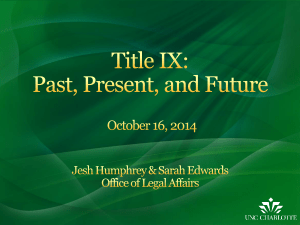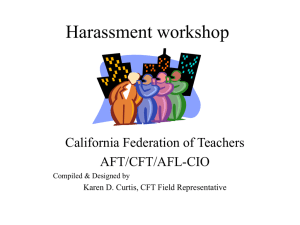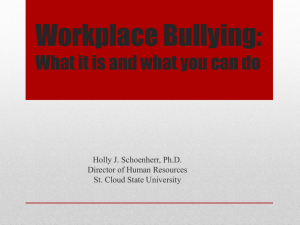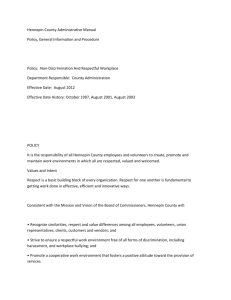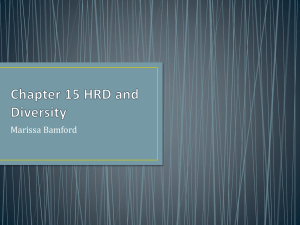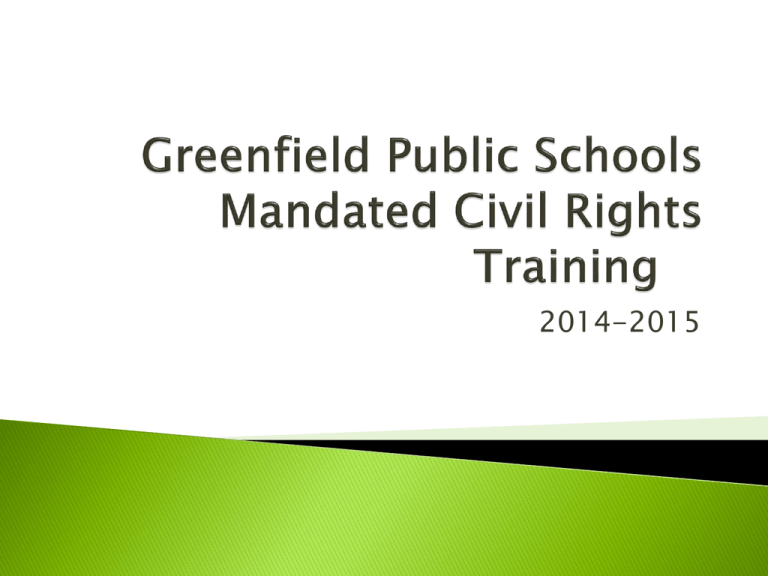
2014-2015
Annual training is mandated by DESE.
All employees are required to participate.
This training protects individuals and the
district and ensures that all employees
know their rights and responsibilities.
2
The Greenfield Public Schools is committed to
ensuring that all programs and facilities are
accessible to all.
We actively seek to prevent discrimination or
harassment on the basis of age, color,
disability, national origin, religion, race or
sexual orientation.
3
Prohibits discrimination or harassment
related to gender, including sexual
harassment.
Refer to the district sexual harassment policy for
specifics regarding steps taken to investigate.
School personnel must contact administrator or
appropriate personnel if a complaint is made.
William Bazyk is the Title IX Coordinator.
4
Protects against discrimination based on
race, color, and national origin.
Applies to students, parents, and
employees.
Prohibits discrimination in student class
assignments or ability tracking and protects
ELL students.
5
Sexual harassment creates a hostile
environment due to inappropriate speech,
materials, or actions.
Sexual harassment is a form of sex
discrimination and includes unwelcome
sexual advances, requests for sexual favors,
or other conduct of a sexual nature.
Sexual harassment interferes with school or
work performance and creates an
intimidating or offensive environment.
6
Examples of prohibited activities that might create a
hostile work/learning environment might include:
◦ vulgar or explicit sexually related epithets, abusive
language
◦ sexually explicit behavior or indecent exposure by
students or employees
◦ graffiti, posters or calendars
7
Any employee or student who believes
he/she has been the victim of harassment
or discrimination should report it to a
teacher, counselor, building administrator,
or the Director of Student Services.
Active investigations will result from the
report, as applicable and may result in
sanctions up to suspension or dismissal.
If the conduct violates the law, the
appropriate authorities will be notified.
8
Enlist parents, students, and community
groups in the effort.
Monitor the school climate and foster respect
and appreciation for diversity.
Be sensitive to religious holidays.
Implement measures to address harassment
immediately and effectively.
Document and report all harassment incidents.
9
Requires that no qualified disabled person
shall be discriminated against or be
excluded from participation in an activity.
A disability is a mental or physical
impairment that limits a person’s major life
activities (self-care, walking, seeing,
learning, breathing, speaking, working).
Reasonable accommodations/modifications
must be made to provide access to
programs and/or facilities.
10
No discrimination against a person with a
disability will be permitted in any of the
programs of the Greenfield Public Schools.
Questions about eligibility and enforcement
should be directed to the building 504
coordinator or an administrator.
The district 504 Coordinator is William Bazyk,
Director of Student Services.
11
Prohibits discrimination against access to
programs and facilities, free appropriate
public education for elementary and
secondary students, and employment
discrimination.
Applies to special education services,
evaluations, IEPs and student discipline.
12
School personnel are mandated reporters.
If school personnel have reasonable cause to suspect
physical or emotional abuse or substantial risk of
harm/neglect they must follow Department of Children
and Families (DCF) reporting requirements.
Please consult with school principal or the district
Director of Student Services for assistance if abuse or
neglect is suspected.
Whenever the school files a 51A with the Department of
Children and Families a copy must be sent to the
Director of Student Services within 24 hours.
13
Any mandated reporter who fails to make
required oral and written reports can be
punished by a fine of up to $1,000.
Effective July 1, 2010, any mandated reporter
who willfully fails to report child abuse
and/or neglect that resulted in serious bodily
injury or death can be punished by a fine of
up to $5,000 and up to 2½ years in jail, and
be reported to the person’s professional
licensing authority.
14
In May of 2010 Governor Deval Patrick signed the
anti bullying law into effect. The law is aimed at
addressing the issue of bullying and cyberbullying in schools.
The bill prohibits bullying at school and school
facilities, school sponsored events and functions,
on buses and at bus stops, through the use of
technology or electronic devices licensed by the
school, and at non-school-related locations and
through personal technology devices if the bullying
affects the school environment.
15
Bullying, the repeated use by one or more
students of a written, verbal or electronic
expression or a physical act or gesture or any
combination thereof, directed at a victim that:
causes physical or emotional harm to the
victim or damage to the victim’s property;
places the victim in reasonable fear of harm
to himself or of damage to his property;
16
creates a hostile environment at school for
the victim;
infringes on the rights of the victim at school;
or
materially and substantially disrupts the
education process or the orderly operation of
a school. For the purposes of this section,
bullying shall include cyber-bullying.
17
Any member of the school staff must
immediately report instances of bullying or
retaliation when it is observed or when they
become aware of the act, to the building
principal or to the person assigned to receive
these reports.
18
Regulation 46.03(1 & 2)
Annually, For ALL staff - Review:
◦ Methods of prevention of need for physical restraint
◦ Types of restraint and related safety considerations
◦ Administering restraint in accordance with
student’s needs/limitations
◦ Required reporting & documentation
19
Physical restraint - "The use of bodily force to limit
a student’s freedom of movement."
Not physical restraint- “Touching or holding a
student without the use of force” --- includes
physical escort, touching to provide instructional
assistance, and other forms of physical contact that
do not include the use of force.
20
Extended Restraint
Longer than 20 minutes.
Increases the risk of injury.
Requires additional written documentation
and report to the Department of Secondary
and Elementary Education.
21
When may physical restraint be necessary?
When other, non-physical, interventions have
been tried and failed or are judged to be
inadequate to the circumstances.
AND a student’s behavior poses a threat of
IMMINENT, SERIOUS, PHYSICAL HARM to self
and/or others
Do not use physical restraint
When non-physical interventions could be
used.
As a response to property destruction, school
disruption, refusal to comply, or verbal threats.
22
Prevention/Learning from the
Experience
Following every restraint action taken, the
circumstances should be discussed with the
student, and with others, as appropriate.
Ask: “How can we avoid this happening
again?”
School maintains a log of all reported
instances of physical restraint in the school.
23
Additional information related to these topics
is available:
Greenfield School Committee Policies
MA Department of Elementary and Secondary
Education
Office for Civil Rights, U.S. Department of
Education
24




